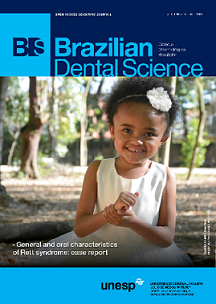Biomechanical behavior of indirect composite materials: a 3D-FEA study
DOI:
https://doi.org/10.14295/bds.2017.v20i3.1444Resumo
Objective: This study aimed to evaluate the influence of the elastic modulus of indirect composite resins (ICR) in the stress distribution of a restored maxillary first premolar. Material and methods: A three-dimensional (3D) finite element model of the tooth and the mesial-occlusal-distal (MOD) restoration was created. Three ICR were simulated, by changing the elastic modulus: 10, 15 and 20 GPa. All materials were considered as isotropic, homogeneous and linearly elastic. An occlusal load (200 N) was applied on occlusal surface trough a sphere, and the nodes of the external surface of the root were fixed. The maximum principal stresses on the tooth and restoration were analyzed. Results: According to FE analysis, the lower the ICR elastic modulus, the higher the stress values generated on the remaining tooth. For the restoration, the opposite was observed: the lower the modulus, the lower the stress. Conclusion: With the limitations of this study it is possible to conclude that the greater the elastic modulus of the restorative material the harder it will be to deflect the cusps, but the easier the fracture of the resin.
Keywords: Finite Elements Analysis; Composite Resin; Indirect Restoration; Flexural Strength.
Downloads
Downloads
Publicado
Como Citar
Edição
Seção
Licença
TRANSFERÊNCIA DE DIREITOS AUTORAIS E DECLARAÇÃO DE RESPONSABILIDADE
Toda a propriedade de direitos autorais do artigo "____________________________________________________________________" é transferido do autor(es) para a CIÊNCIA ODONTOLÓGICA BRASILEIRA, no caso do trabalho ser publicado. O artigo não foi publicado em outro lugar e não foi submetido simultaneamente para publicação em outra revista.
Vimos por meio deste, atestar que trabalho é original e não apresenta dados manipulados, fraude ou plágio. Fizemos contribuição científica significativa para o estudo e estamos cientes dos dados apresentados e de acordo com a versão final do artigo. Assumimos total responsabilidade pelos aspectos éticos do estudo.
Este texto deve ser impresso e assinado por todos os autores. A versão digitalizada deverá ser apresentada como arquivo suplementar durante o processo de submissão.




























